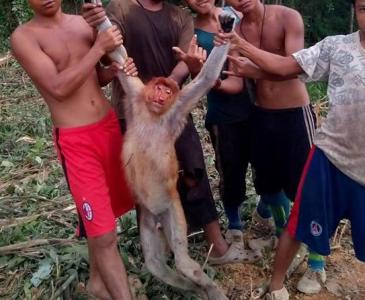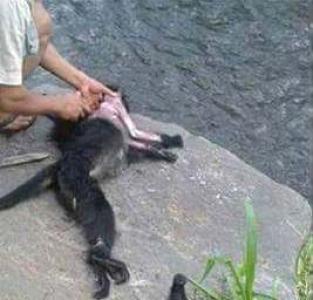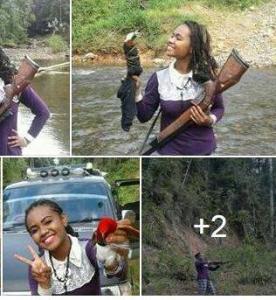Top Wildlife Poaching Cases in Social Media throughout 2016
 Photos of wildlife poaching activities posted on social media sees no decline in 2016. Showing no remorse, nor compassion, many people seem to be proud of their horrid posts. The fact that such act is violating the law, especially when they prey on protected wildlife species, does not occur in their mind.
Photos of wildlife poaching activities posted on social media sees no decline in 2016. Showing no remorse, nor compassion, many people seem to be proud of their horrid posts. The fact that such act is violating the law, especially when they prey on protected wildlife species, does not occur in their mind.
In 2016 alone, PROFAUNA received no less than 85 reports regarding wildlife poaching activities posted on social media. However, penalty has not been given to any poacher due to lack of evidence and obscure location.
"There are 5 wildlife poaching cases advocated by PROFAUNA in 2016. All suspects have been identified, but no further penalty applied to them," said Swasti Prawidya Mukti, PROFAUNA's campaign officer.
Here are the top 4 prominent wildlife poaching cases appeared in social media in 2016:
Killing of Javan Langurs in Lumajang
 Poaching activities of the Javan Langur posted on Facebook by user named Addhi Gokhil in January 2016 showed more than three dead langurs tied to a piece of wood. PROFAUNA's immediate report was responded by the East Java Nature Conservation Agency by coming to the alleged location.
Poaching activities of the Javan Langur posted on Facebook by user named Addhi Gokhil in January 2016 showed more than three dead langurs tied to a piece of wood. PROFAUNA's immediate report was responded by the East Java Nature Conservation Agency by coming to the alleged location.
Based on information received by PROFAUNA and further investigation by the BKSDA, we learned that the killing act took place at Desa Sidomulyo, Pronojiwo, Lumajang regency. It was likely that the langurs were hunted within the area of Bromo Tengger Semeru National Park. We managed to identify the poacher but no further legal penalties was given.
The Eaten Proboscis Monkey
Proboscis Monkey are still prone to poaching, as shown by a Facebook user named Uchu Adam Dhoang in June 2016 when he posted his ghastly photos of a dead Proboscis Monkey being held by several men. PROFAUNA opened our community report line, and gained some serious responses including from Daniel Johan, a member of the House of Representatives. A native of West Kalimantan, Johan suggest that the local government increase the protection mangrove ecosystem and the animals within.
Six suspects have been identified and seized in a timber company in Senoni, Lebak Silong, Sebulu, Kutai Kartanegara regency, West Kalimantan on 13 June 20016 by East Nature Conservation Agency, West Kalimantan Nature Conservation Agency, and Sambas Police. All of them came from Sambas, West Kalimantan. They admitted the conduct, and that they have eaten the monkey. No penalties were given to them.
Sun Bear Slaughter
The Sun Bear slaughter case appeared on Facebook account named Rosi Kuale in August 2016 was dreadful. A photo showing a dead Sun Bear tied to a piece of wood with an open wound across its neck infuriated Facebook users. PROFAUNA received a number of reports, which was later followed up by West Java Nature Conservation Agency.
On 1 September 2016, Sambas Police, Jawai Police, Singkawang Nature Conservation Agency, and several local community leaders met the family of Joko a.k.a Lobo, the real owner of the Facebook account at his original residence at Dusun Timur RT 12 RW 06 Sei Nilam, Jawai, Sambas regency, West Kalimantan. This case could not be prosecuted further because it turned out that the slaughter took place in Bintulu, Sarawak, Malaysia.
Poached Birds of Paradise
 The poaching case of Birds of Papua posted on Facebook by an account named Feronica Natalia Saman in November 2016 went viral after PROFAUNA received lots of reports from enraged public. From there reports, we collected important information related to her location. Further investigation also revealed that she is fond of poaching other animals too.
The poaching case of Birds of Papua posted on Facebook by an account named Feronica Natalia Saman in November 2016 went viral after PROFAUNA received lots of reports from enraged public. From there reports, we collected important information related to her location. Further investigation also revealed that she is fond of poaching other animals too.
The case became a nationwide sensation, even the Governor of Papua condemned this. West Papua Nature Conservation Agency conducted field investigation because Feronica comes from Sorong, but later the case was handed over to Papua Nature Conservation Agency as the suspect has been living in Nabire for a while. Sadly, this student of the University of Papua was only given a warning on 27 November 2016.
